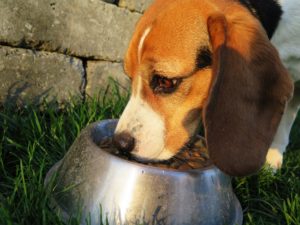The Benefits of a Grain Free Dog Food

When we purchase food for our family we think about the quality, the ingredients, and the benefits to our health. Why should our pets be any different?
Due to food allergies many pet parents choose grain free foods for their dogs, but the benefits from grain free food aren’t limited to dogs with allergies.
What should be in our dog’s food?
Dogs are omnivorous animals and should get a balanced diet of carbohydrates, protein, healthy fats, vitamins, and minerals. PetMD.com says eighteen to twenty five percent of a dog’s food should be made up of protein and up to seventy percent should come from carbohydrates, and grain free foods are meat based with healthy vegetables making them an excellent source for the proper nutrition a dog needs.
 Why is it important to make sure our dogs get the proper nutrients?
Why is it important to make sure our dogs get the proper nutrients?
Dogs that are getting the proper nutrition will have an easier time digesting food, there will be less waste, and the dog will have less flatulence and less frequent, smaller stools. They will also have visible changes such as a healthier coat, weight, and higher energy levels.
How much does grain free food cost?
The cost of grain free foods is very similar and comparable to the most popular brands of dog food that are currently available in stores. Some pet parents even choose to make their own grain free foods at home made from meats, healthy vegetables and sometimes alternative grains like rice so that they know exactly what they are feeding their pet.
How can I figure out which foods are grain free?
An online search, reaching out to friends, or asking your veterinarian can all be good starting points to finding a grain free food that is right for your dog. Grain free foods will be labeled as grain free, so if you prefer a hands-on approach you can read labels in the store or speak to the employees who will be knowledgeable in directing you to grain free food.
 If my dog hasn’t been eating grain free food, what’s the best way to switch their diet?
If my dog hasn’t been eating grain free food, what’s the best way to switch their diet?
Changing a dog’s food at anytime should be gradual, whether grain free or not, to avoid digestive issues. Most veterinarians will suggest gradually increasing the percentage of the new food in the mix over five to seven days. If at any time the dog shows digestive distress, for example with vomiting or diarrhea, a pet parent should always contact the vet’s office right way.
Should I consult with a veterinarian before I switch my dog’s food?
As always with any change in your pet’s diet, especially if the pet is already on a veterinarian recommended diet, the veterinarian’s office will tell you the best approach to switching your pet’s food. As a pet parent, if you have concerns your dog may have a food allergy the veterinarian can determine this for you and will recommend a new food.
When it comes to making the decisions that will best benefit your pet, it is a personal choice and no one choice will be the right one for everyone. With a little knowledge and research, a pet parent can make the choice for them and their pet, because when the pets have the best options on the inside, it shows on the outside.
Do you feed your dog grain-free food? Why or why not? Leave a comment and let us know!

You got me when you talked about how dogs can have an easier time to digest food and will have high energy levels if they get the proper nutrition that they need. With that in mind, I’ll make sure to shop for grain-free dog food that you suggested. Our dogs seem weak and underweight because they don’t really eat proper meals. We want them to be active and playful, so we’ll do all your tips.